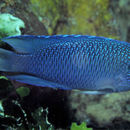Diagnostic Description
provided by Fishbase
Description: Recognized by the brilliant light-blue color (Ref. 48636). This species exhibits a marked sexual dichromatism: juveniles and females usually have a small black spot at the rear base of the dorsal fin and (at least in Micronesia) lack yellow; males have a bright yellow snout and tail and sometimes, latter all orange in some regions; also lack the black spot (Ref. 7247). Body depth 2.2-2.4 in SL (Ref. 90102).
Diseases and Parasites
provided by Fishbase
Livoneca Infestation. Parasitic infestations (protozoa, worms, etc.)
Life Cycle
provided by Fishbase
Oviparous, distinct pairing during breeding (Ref. 205). Eggs are demersal and adhere to the substrate (Ref. 205). Males guard and aerate the eggs (Ref. 205).
Morphology
provided by Fishbase
Dorsal spines (total): 13; Dorsal soft rays (total): 12 - 13; Analspines: 2; Analsoft rays: 13 - 14
Trophic Strategy
provided by Fishbase
Found amongst rubble and coral of clear sheltered lagoons and reef flats (Ref. 9710). Occurs in groups of a male and several females or juveniles (Ref. 1602). The habitat consists of lagoons and protected inshore reefs in knee-depth shallows down to about 10 m (Ref. 54301). Feeds on plants and invertebrates (Ref. 6110). Diurnal species (Ref. 113699).
Biology
provided by Fishbase
Adults are found amongst rubble and coral of clear sheltered lagoons and subtidal reef flats (Ref. 9710, 48636). They occur in groups of a male and several females or juveniles (Ref. 1602). Feed on algae, pelagic tunicates and copepods. Oviparous, distinct pairing during breeding (Ref. 205). Eggs are demersal and adhere to the substrate (Ref. 205). Males guard and aerate the eggs (Ref. 205). Diurnal species (Ref. 113699).
- Recorder
- Estelita Emily Capuli
Importance
provided by Fishbase
aquarium: commercial
- Recorder
- Estelita Emily Capuli
分布
provided by The Fish Database of Taiwan
廣泛分布於印度-太平洋區,包括印度洋東緣、澳洲西部至新幾內亞、新不列顛島,所羅門群島、馬里亞納群島、加羅林群島、印尼、菲律賓、台灣與琉球群島。另外萬那度、新加勒多尼亞、密克羅尼西亞的帛琉與雅普島以及美屬薩摩亞也有記錄。台灣各沿岸礁區可見。
利用
provided by The Fish Database of Taiwan
本身體色豔麗使其成為受歡迎之水族觀賞魚。
描述
provided by The Fish Database of Taiwan
體呈橢圓形而側扁,標準體長為體高之2.2-2.4倍。眼中大,上側位。口小,上頜骨末端僅及眼前緣。眶下骨裸出;前鰓蓋骨後緣平滑。頰部有鱗2列。體被櫛鱗;側線之有孔鱗片16-19個。鰓耙數17-19。背鰭單一,軟條部不延長而呈角形,硬棘XIII,軟條12-13;臀鰭硬棘II,軟條12-14;胸鰭鰭條18-19;尾鰭內凹形,上下葉末端呈圓形。體呈淺藍色,有顯著的性別雙色變異:稚魚與雌魚通常在背鰭基底後面有一個小的黑色斑點,但缺乏黃色的體色;雄魚的吻部及尾鰭鮮黃色,某些區域裡則具有橘色的尾鰭,背鰭基底後面皆無黑色的斑點。
棲地
provided by The Fish Database of Taiwan
主要棲息於清澈隱蔽的潟湖碎石堆、珊瑚區及亞潮間帶的礁石平臺。通常以群體出現,包括一隻雄魚、好幾隻雌魚或稚魚。以藻類、大洋性的被囊類及橈腳類的浮游動物為食。
Chrysiptera cyanea
provided by wikipedia EN
Chrysiptera cyanea is a species of damselfish found in the wide Indo-West Pacific but not known in the Red Sea.[1] A few individuals were observed in the Mediterranean Sea in 2013 off Slovenia, a likely aquarium release.[2]
Common names include blue damselfish, blue demoiselle, blue devil, cornflower sergeant-major, Hedley's damselfish, red tail Australian damsel, sapphire devil, and sky-blue damsel.[3]
Description
This fish reaches 8.5 centimeters in length. It is bright blue in color; the male has a yellow snout and tail, and the female and juvenile usually lack yellow but have a black spot at the base of the back edge of the dorsal fin.[1][4]
Behavior
The fish inhabits reefs and lagoons. Its diet includes algae, tunicates, and copepods. Male and female pair up for breeding, and the male guards and tends the eggs.[1]
In aquarium
It is very aggressive. A matched couple often attacks any same size fish approaching its breeding territory.[4]
References

- license
- cc-by-sa-3.0
- copyright
- Wikipedia authors and editors
Chrysiptera cyanea: Brief Summary
provided by wikipedia EN
Chrysiptera cyanea is a species of damselfish found in the wide Indo-West Pacific but not known in the Red Sea. A few individuals were observed in the Mediterranean Sea in 2013 off Slovenia, a likely aquarium release.
Common names include blue damselfish, blue demoiselle, blue devil, cornflower sergeant-major, Hedley's damselfish, red tail Australian damsel, sapphire devil, and sky-blue damsel.

Wikimedia Commons has media related to
Chrysiptera cyanea.
 Wikispecies
Wikispecies has information related to
Chrysiptera cyanea.
- license
- cc-by-sa-3.0
- copyright
- Wikipedia authors and editors

